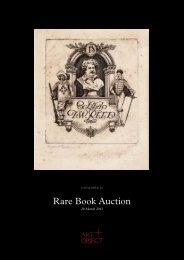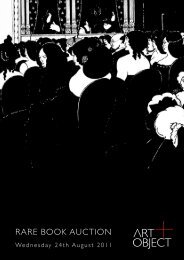You also want an ePaper? Increase the reach of your titles
YUMPU automatically turns print PDFs into web optimized ePapers that Google loves.
77<br />
Ralph Hotere<br />
Ulysses<br />
acrylic on unstretched canvas<br />
title inscribed, signed and dated Carey’s<br />
Bay VI – ’81 and inscribed For A and N<br />
1825 x 910mm<br />
$120 000 – $160 000<br />
Lyrical, portentous, yet strongly affirmative with its powerful ‘Yes’, Ulysses<br />
is exemplary of Hotere at peak performance. While the artist is re<strong>now</strong>ned<br />
for working in organised series, his sequences do not simply begin and end,<br />
following each other in neat procession. In fact, the series overlap a great<br />
deal. Ulysses lies at the intersection of several series Hotere was working on<br />
more or less simultaneously in 1981, a year of great productivity stimulated<br />
by a variety of tensions in the artist’s life and environs. In Ulysses we witness<br />
Hotere still working through the Roman Catholic imagery that resulted in the<br />
series k<strong>now</strong>n as Le Pape est Mort, commenced while the artist was resident<br />
in France in 1978. Profoundly influenced by French Catholic traditions present<br />
in the Northland community into which he was born, Hotere returns again<br />
and again to Catholic themes. However these traditions are not always the<br />
principal concern of individual works by Hotere – often they provide vehicles<br />
and analogies for addressing other ideas.<br />
Though Catholic references in Ulysses are overt in the Latin script, meaning<br />
‘I shall go up to the altar of God’, their interpretation is ambiguous. James<br />
Joyce’s novel Ulysses seems a likely reference here. Joyce’s novel deals in<br />
part with the effects of different cultural strains coexisting in each fictional<br />
character. It contains motifs that are also present in Hotere’s work. The beach<br />
for example: in 1981 Hotere was becoming increasingly involved in the growing<br />
protest movement against a possible aluminium smelter at Aramoana at the<br />
Otago Heads. Symmetrically enough to suggest a symbolic connection,<br />
Aramoana has a beach called Sandy Beach, while Stephen Dedalus, a major<br />
character in Joyce’s Ulysses, is immersed in philosophical contemplation at<br />
Sandymount Strand near Dublin, as he tries to come to terms with the death<br />
of his mother. The character of Dedalus is related to the mythical Greek<br />
character, who made wings so that he and his son Icarus could fly – resulting<br />
in Icarus’ fatal fall when he flew too close to the sun. This association is<br />
reinforced in Hotere’s Ulysses not only in the Latin inscription but also in the<br />
presence of the powerful circle or dark sun motif, an image frequently linked to<br />
environmental concerns in his works.<br />
Besides the strong relationship to Hotere’s Le Pape est Mort series, Ulysses is<br />
also closely allied to another series in production at this time, the Aramoana/<br />
Aurora works, inspired by the artist’s experience of the Southern Lights. Over<br />
the next few years the electromagnetic currents of the aurora featured in these<br />
works morph into the sinister sparks given off by the threatening aluminium<br />
smelter. A taste of these powerful forces can be seen in the wiry, electric red,<br />
high-energy currents appearing in a wedge within the looming circle in Ulysses.<br />
Oliver Stead<br />
58

















